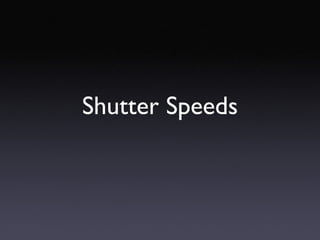Shutter Speeds
- 2. The amount of time that the film is exposed to light. The amount of action rendered in the photograph. Shutter Speeds control Two Things
- 3. Shutter Speeds range from B to 1000. B stands for Bulb, which means when you depress your shutter release button the shutter will stay open until the button is released. These are examples of the most common shutter speeds: 1 2 4 8 16 32 60 125 250 500 1000 Shutter speeds range from 1 which is 1 second. The other shutter speeds are actually fractions of a second 1/2 to 1/1000 of a second.
- 4. Never use a shutter speed below 1/60 of a second when holding your camera in your hands. Anything below this can cause a chance for camera movement and blurring of your image. You would want to use a tripod for slower shutter speeds. The faster the shutter speed the more there will be freezing or Stopping action in an image. The lower the light the slower the shutter speed should be to allow more time for the film to be exposed. Rules of Shutter Speeds
- 5. Too Slow of shutter speed for hand holding your camera
- 6. Faster Shutter Speed for Stop Action
- 7. Too Slow of Shutter Speed.
- 8. Shutter Speed fast enough to Stop Action
- 9. Movement faster than the shutter speed
- 10. Shutter Speed increased to Stop Action
- 11. Ã˝
- 12. Ã˝
- 13. Ã˝
- 14. Ã˝














